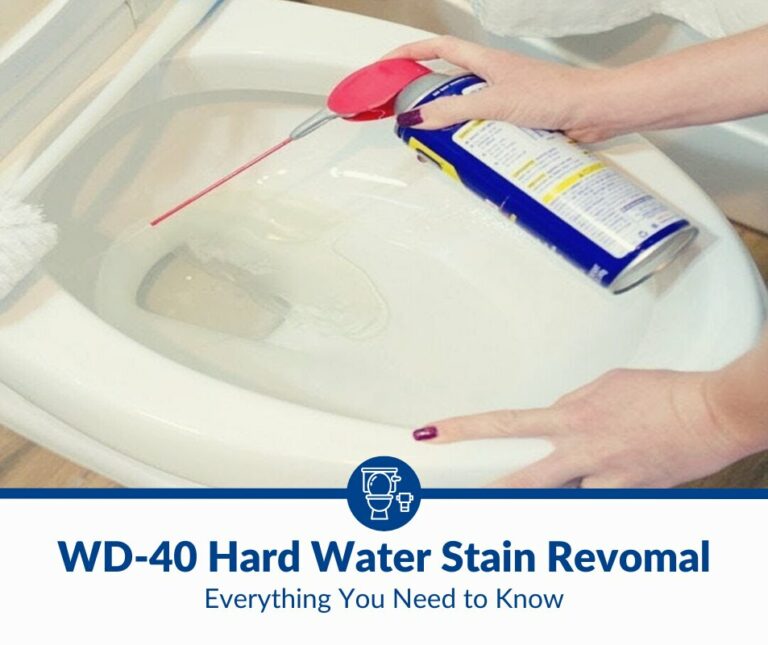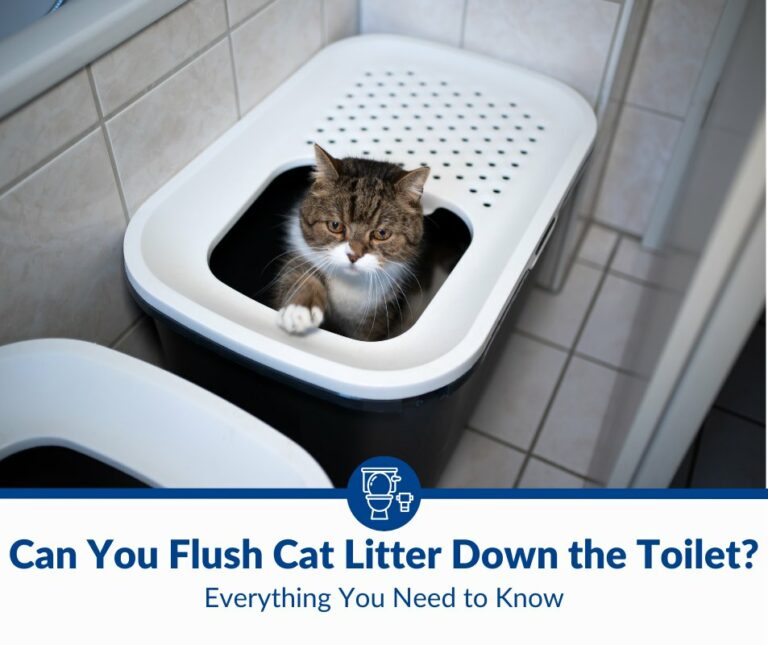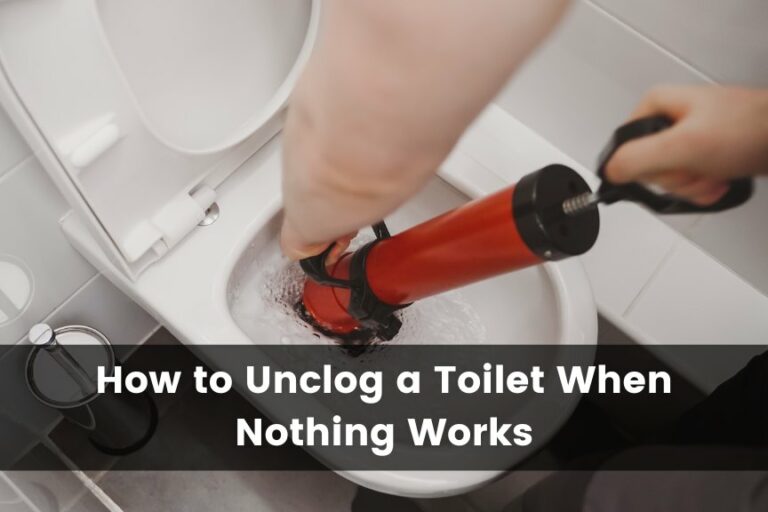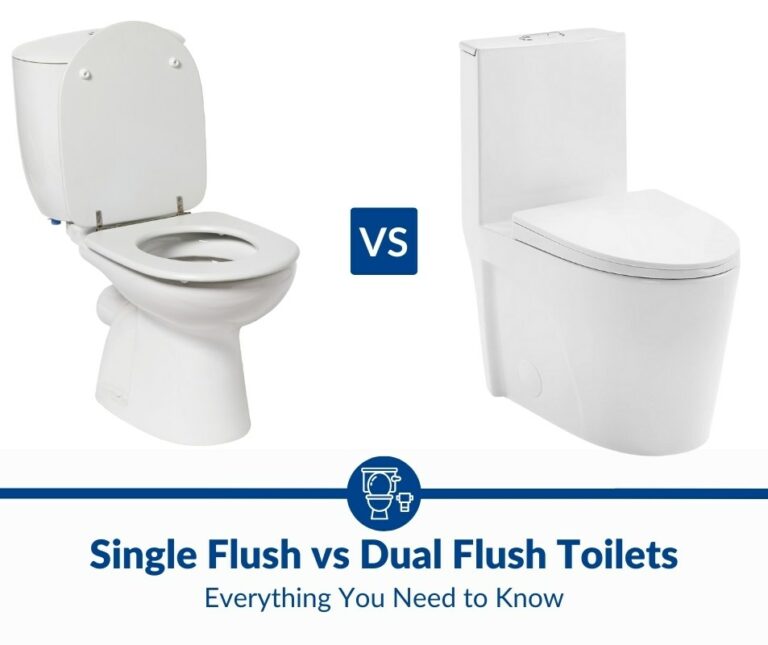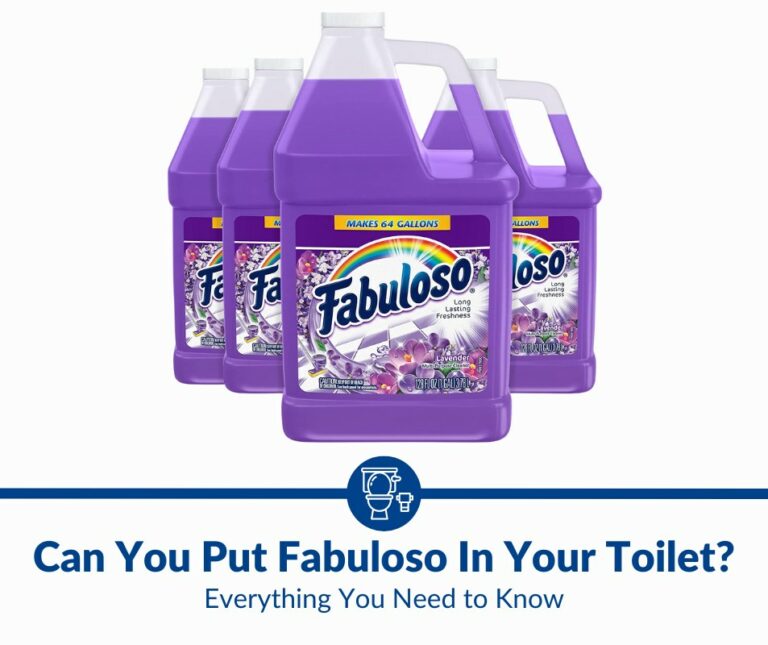Brown Stains at the Bottom of Your Toilet? Causes and Fixes
Using your toilet bowl with brown stains or rings can be off-putting. Luckily, there are many ways to get rid of these unsightly spots.
Brown stains at the bottom of your toilet are often caused by a buildup of minerals and dirt. A simple fix is to use a vinegar and baking soda mixture to loosen the buildup. Then, use a brush, sponge, or pumice stone to dislodge the loosened minerals.
We all want our toilets to shine and shimmer, free of brown stains. This article will expand on the causes and fixes for these icky problems. Let’s get started!
1. Brown Toilet Stains That Are Caused by Mineral Buildup
After you’ve had your toilet bowl for some time, you might notice some brown rings or stains even when you flush and clean it religiously. These toilet brown stains are often caused by mineral buildup and the accumulation of dirt and grime.
But where do such minerals come from in the first place? The simple answer is hard water, which is often used for toilets or bathrooms.
Hard water is abundant in calcium, magnesium, and other minerals. You won’t see them accumulating in the bowl because the buildup begins as a chalky or off-white deposit, also known as limescale. So, it blends in pretty well with your white porcelain bowl.
As time passes, dirt and grime get stuck on the deposits, and the buildup becomes brownish and darker. Left unchecked, they can accumulate and harden, making them more challenging to remove.
How To Fix
If you’re wondering how to get rid of brown stains in your toilet bowl caused by mineral buildup, you have several options.
Use Acidic Substances To Clean Your Toilet
Acid works best at breaking down mineral deposits in toilets, making them easier to scrub or flush. Luckily, there’s a large variety of acidic substances that will work to clean brown stains in toilets.
- Vinegar. Mix vinegar with baking soda (2:1 ratio), then pour the mixture into the toilet bowl. Let it sit for as long as possible, then scrub it away with cleaning materials like a brush. After cleansing, flush out all the substances and dislodged minerals and dirt.
- Lemon. If vinegar doesn’t work well enough, you can use lemon juice, which is slightly more acidic than vinegar. Apply the lemon juice on the offending spots using a spray bottle.
- Baking soda. Baking soda is actually not an acid. Still, this substance is an effective cleaning agent, often used in conjunction with other acidic substances like vinegar, lemon, borax, coca-cola, and citric acid.
- Borax. You can mix this with salt and vinegar to make a cleaning solution. The combination of the three is really effective in breaking down mineral deposits in the toilet. Alternatively, you can use Borax paste alone.
- Coca-Cola. This popular beverage is also acidic, but you must use it with baking soda to avoid turning the bowl into a darker brown color. Moreover, you need to let it sit for longer (like overnight) to work.
- Citric acid. A solution of boiling water and citric acid can remove brown stains at the bottom of your toilet. All you have to do is let the water and acid sit for a few hours before scrubbing.
- Dishwasher tablet. If you use dishwasher tablets, put one into your toilet and let it dissolve. You can scrub it a bit to dissolve faster, then let it sit. Clean and flush after a few hours.
- Industrial or stain cleaner. There are many available pre-made stain cleaners in physical or online stores. Buy one and use it as directed.
- Calcium, lime, and rust (CLR) remover. This solution is highly recommended if the stain is especially tough to remove. I highly recommend this CLR Multi-Use Calcium Remover from Amazon.com. You don’t need to let it sit for long, and it can be used on other surfaces like tiles, showerheads, tubs, and, of course, toilets.
- Hydrogen peroxide. Use a 3% solution to deal with manganese-caused stains and mold. Do NOT mix with vinegar.
- Tartar cream. The essence of this powder is potassium bitartrate, an acid that can be used for cleaning.
- Muriatic acid. This is the most effective at cleaning stains, but I don’t recommend it for use at home by non-professionals. It can be incredibly toxic if not used properly. If none of the above solutions work, you should hire a professional to clean your toilet bowl.
I should also note that you should NOT use the following to clean your toilet bowl:
- Ammonia
- Bleach
Those two substances can release toxic fumes that can harm you.
Additionally, each of the options mentioned above varies in acidity. You can refer to the chart below based on the University of Arkansas Extension’s alternative toilet bowl cleaners:
| Cleaning Strength | Solution |
| Mild | Baking soda + vinegar |
| Moderate | Borax + hot water |
| Strong | Borax + vinegar |
If the brown stains in your toilet are still faint and a few days old, you can use mild or moderate cleaners. However, if they’re incredibly tough to remove because the bathroom hasn’t been used for weeks or months, it’s better to go for the borax and vinegar combo. You can also try industrial cleaners, which are pretty strong.
Whichever acidic substance you use, you must let it sit in the toilet bowl for some time before scrubbing. During that period, the acid gets to work by breaking down the mineral deposits.
If you rush the process, a buildup might still be stuck to the bowl, no matter how hard you scrub. You may even have to repeat acid soaking and cleaning several times before you get your toilet bowl to its natural glory.
Have the Right Cleaning Materials
Speaking of scrubbing (a crucial and exhausting phase of toilet cleaning), you’ll need some cleaning materials, such as the following.
- Brush. It’s best to use a nylon brush, not a metal wire brush, to avoid scratching or damaging the porcelain toilet. You can even use an old toothbrush (though that has the added disadvantage of getting your hands a little too close to the bowl for comfort).
- Pumice stone. Use this with a bit of water to avoid abrasions.
- Sponge. It’s best to use some of the more abrasive types for it to be effective.
- Sandpaper. Be extra careful if you use sandpaper. You may damage your toilet if you scrub too hard with it.
- Gloves. It’s essential to use gloves, especially when you’re scrubbing with sandpaper, to protect your hands.
- Disinfectant spray. After cleaning the toilet, you’ll need to disinfect your cleaning materials. This helps prevent the spread of bacteria and other possibly pathogenic organisms.
Hire a Professional Cleaner
You can call professional cleaners if you’re not up for manual cleaning. Not only do they know how to remove the stains and dirt in every nook and cranny, but they also know what products are most effective.
Some services will be pricey, but the convenience is worth it. You can also choose cleaners in your area to minimize costs.
How To Prevent Mineral Buildup in Your Toilet
The best fix for brown stains at the bottom of your toilet is to prevent them from occurring in the first place. The following are some ways to prevent mineral buildup in your toilet.
Use a Water Softener
One way to remove mineral buildup is with a water softener, an appliance that uses ion exchange, and a resin filter to filter out iron, calcium, and magnesium.
Water softeners are actually available on Amazon.com, and here are the best-selling ones:
- Aquasure Harmony Series Whole House Water Softener. This comes with a digital meter and programmable control head, which makes it easier to monitor and adjust hardness levels. The warranty is set for five years, too.
- Whirlpool WHES40E 40,000 Grain Softener. This water softener is ideal for large households (up to six people). It can also remove iron at a concentration of up to 10 ppm.
Before you get a water softener, though, you should know that installing one takes a lot of work. They’re also only recommended at a specific water pH and hardness level. Plus, you need to ensure that the product you choose is not exposed to air or chlorine, or you’ll risk getting oxidized minerals that can affect the water softener.
It’s better to consult a professional company or water specialist to conduct tests to check whether a water softener is appropriate for your toilet. You also need to discuss maintenance because these appliances must be maintained properly to be durable and efficient over the long term.
Clean Your Toilet Regularly
Besides using a water softener, regular cleaning is an inexpensive and easy way to prevent brown stains from appearing. If you can do that daily, even better. Everyday cleaning prevents minerals from accumulating. However, if not possible, you can go for a weekly schedule.
You shouldn’t let the brown stains and deposits accumulate for long because they can dislodge over time and clog pipes, which can cause even more significant issues. Thus, if you have any standby toilets, like those in guest rooms, flush them now and then to avoid quicker buildup.
2. Brown Toilet Stains That Are Caused by Rust
Iron is also present in toilet water. It often comes from unfiltered sources, like wells in contact with iron-rich rocks. However, it may also be due to deteriorating water pipes whose crumbled iron pieces get carried away in the current.
When iron is exposed to oxygen, it turns into rust, leading to toilet brown stains or rings. So, if you see dark discolorations on your toilet bowl, it can be both mineral buildup and rust.
How To Fix
Fortunately, you can remove rust from your toilet bowl. Like stains caused by mineral buildup, removing rust requires manual effort and the right cleaning substances, such as:
- Rust and stain remover. Many pre-made solutions are effective against both rust and mineral buildup stains. This Iron OUT Powder Rust Stain Remover on Amazon.com works well against different surfaces, in and out of the bathroom. It’s septic-safe and is formulated to work against iron and hard water minerals.
- WD-40. This WD-40 Specialist Penetrant with SMART STRAW SPRAYS 2 WAYS (available on Amazon.com) is a known product for breaking down and protecting against rust. This specific WD-40 is easier to control, so you can release either a stream or spray of solution.
How To Prevent Rust in Your Toilet
Use Toilet Bowl Cleaner Tablets
One way to remove rust from your toilet is to use toilet bowl cleaner tablets, like the Iron OUT Automatic Toilet Bowl Cleaner (available on Amazon.com) However, you should put a tablet only after you’ve scrubbed away all the gunk in your toilet. Each tab lasts 45 days, and all the while, it prevents stains or rust from occurring.
Use Water Softeners
A water softener is also good at preventing rust because it removes iron, as explained above. However, this option is only recommended at a specific iron concentration. Therefore, when calling in a water specialist, have your water tested thoroughly before installing a water softener.
Replace Your Plumbing Pipes
As I’ve mentioned earlier, the iron can also come from bits of old metal coming off your pipes. So, it’s also a good idea to replace old or deteriorating pipes within your plumbing system. Aside from keeping your toilet bowl clean, this can also prevent other issues like contamination of your water supply.
3. Brown Toilet Stains That Are Caused by Bacteria
Bacteria can thrive in mineral-rich environments like hard water, making brown spots as well. These bacteria may come from water sources (like wells) and get carried by the current into your toilet bowl.
Specifically, three known types of bacteria can cause brown stains at the bottom of your toilet:
- Iron bacteria. When this type of bacteria proliferates, it takes on a rust color. It’s also capable of oxidizing iron to form rust deposits.
- Manganese bacteria. As their name suggests, these bacteria thrive in manganese-rich waters. They can form a brownish-to-black slime in your toilet.
- Sulfur bacteria. These bacteria are present in sulfur-rich waters. They metabolize the substance by reducing or oxidizing it, producing a dark slime. Another good indicator of the presence of sulfur bacteria is the smell of rotten eggs.
How To Fix
You can remove bacteria from your toilet by cleaning it with the substances I’ve mentioned above, such as acids and CLR cleaners. However, they may not be as effective as the other measures I’ll discuss below.
Use Shock Chlorination
One common way of dealing with toilet bacteria is chlorine. For this purpose, it’s often applied through shock chlorination of your source well. It treats the source water so no bacteria are carried into the toilet and other parts of the house.
However, shock chlorination is not a recommended long-term solution. Doing so often can corrode your pipes and wells, causing significant damage.
Install a Chlorine Injection System
You can also apply chlorine using an injection system. Instead of directly adding chlorine to the water source (e.g., well), the water is passed onto a tank. The chlorine is applied inside the tank before being sent through the pipes. This way, bacteria in the water source cannot get carried into the toilet.
However, this system only works well with a carbon filter, which can remove excess chlorine. This filter is especially important if your water source is used throughout the home, not just in the toilet. After all, you don’t want too much chlorine in your water.
If you plan to have this system installed, reach out to a local expert for help.
Use a Water Filter
You can also use water filters that remove iron, manganese, and sulfur bacteria. Standard filters may not do an excellent job at that task, so these two are recommended:
- Ozone. Ozone gas passes through the water, killing the bacteria it carries.
- UV light. UV light targets DNA bacteria. Once the DNA gets affected, the species gets killed, making this filter one of the most effective and efficient at eliminating harmful microorganisms.
However, before you install any of these filters, consult an expert because a specific type may not be effective for your setup. For instance, UV light filters aren’t recommended for private wells because there’s too much iron.
Use Water Softeners
Water softeners that prevent iron, manganese, and sulfur buildup may also prevent bacteria from residing in toilets. Without essential minerals, they cannot thrive. Although this seems like a solution that can kill two birds with one stone, you should double-check with a professional to see whether this sort of chemical is appropriate for your situation.
Summary
The brown stains at the bottom of your toilet are usually caused by mineral buildup or the accumulation of substances like calcium, manganese, and iron. They begin as white deposits that become brown over time because of mixed-in dirt and grime.
They’re usually removed by being soaked and cleaned with acidic solutions, like vinegar. For a long-term solution, installing a water softener and filter is ideal.


